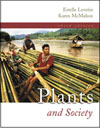
The Plant Body |  |
Chapter Summary1. Meristems are regions of active cell division and are the source of cells for the various tissue types in the plant body. Growth at apical meristems is primary growth. Increase in the girth in woody plants is called secondary growth.
2. There are three basic tissue types in plants: dermal, ground, and vascular. Dermal tissues include the epidermis and periderm and cover the surface of a plant. Ground tissues include parenchyma, collenchyma, and sclerenchyma. Parenchyma is the most abundant and versatile plant tissue, functioning in storage and photosynthesis. Both collenchyma and sclerenchyma are tissues of support. There are two types of sclerenchyma: fibers and sclereids.
3. Vascular tissues are the conducting tissue in plants. Xylem conducts water and minerals from the soil upward; and phloem moves organic solutes throughout the plant body. Tracheids and vessel elements are the water-conducting cells of xylem. Sieve tube members, assisted by companion cells, conduct organic solutes through the phloem.
4. The vegetative organs of the plant body include roots, stems, and leaves. Roots anchor the plant and absorb water and minerals from the soil. Two types of root systems are found: taproot and fibrous root. At the tip of any root there are four distinct regions, or zones: root cap, zone of cell division, zone of cell elongation, and zone of maturation. Vascular tissue in a nonwoody root is organized into a stele; the pattern of xylem and phloem in the stele varies in monocot and dicot roots. The stele is surrounded by a cortex and an outer layer of epidermis. Extending from the epidermal cells are root hairs through which most of the water and minerals that enter a root are absorbed.
5. Stems support leaves to maximize light absorption and are part of the conduit for the transport of water, minerals, and organic solutes. Leaves are the main photosynthetic structures in most plants. Unlike roots, the vascular tissue in both stems and leaves is organized into vascular bundles. In stems of herbaceous dicots, the vascular bundles are arranged in a ring around a pith; in monocots, the vascular bundles are scattered. In woody dicots, the discrete vascular bundles are replaced by continuous rings of xylem that correspond to the xylem produced during a single growing season.
6. A leaf may have three parts: the blade, the petiole, and a pair of stipules. If the blade is undivided, the leaf is said to be simple; if the blade is divided into separate leaflets, the leaf is compound. According to the pattern of the leaflets, compound leaves may be pinnately or palmately compound. Leaf venation patterns are either parallel (most monocots) or net (most dicots). The entire leaf surface is covered by epidermis; the epidermis secretes a waxy layer, the cuticle. Guard cells are found in the leaf epidermis. They regulate the entry and exit of gases through the stomata. The mesophyll of the leaf is composed of photosynthetic parenchyma cells, palisade and spongy cells.
7. An examination of the produce section of a supermarket reveals that many of our common vegetables can be identified as being one of the organs of a plant. Many vegetables have a value beyond the culinary as sources of medicine and folklore.
|
|
|